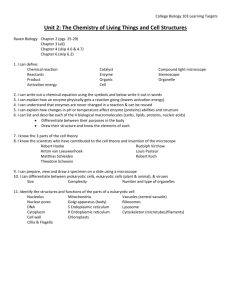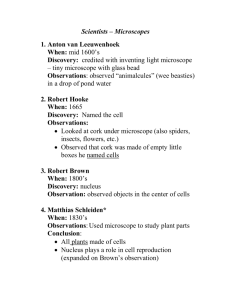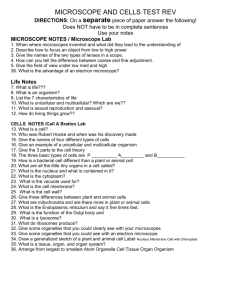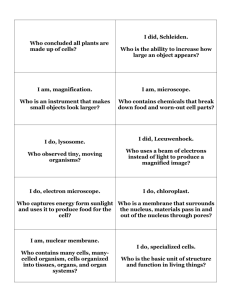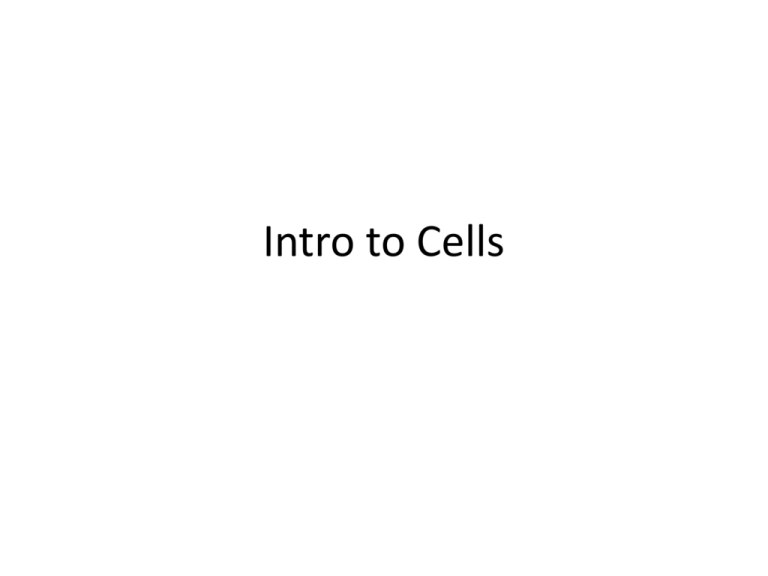
Intro to Cells
The Discovery of the Cell
• The Discovery of the Cell
• Because there were no instruments to make cells
visible, the existence of cells was unknown for most of
human history.
• This changed with the invention of the microscope.
Cell
• The smallest unit of life that can carry on all of
the functions of life
• Unicellular – single cell
• Multicellular – many cells
Early Romans during first century A.D. used crystals to
Magnify objects.
Towards the end of the 13th century lenses were ground
for spectacles.
Anton Van Leeuwenhook
• Dutch inventor who created the microscope
that we recognize today
• First person to discover a single celled
protozoa
– Protozoa is like pond scum
• He also looked at blood cells
vanLeeuwenhoek’s
1stmicroscope
First to see and describe bacteria, yeast, and
animalcules
1590- Dutch lens makers that first
experimented with compound microscopes.
Early Microscopes
• In 1665, Robert Hooke used an early
compound microscope to look at a thin slice
of cork, a plant material.
• Cork looked like thousands of tiny, empty
chambers.
• Hooke called these chambers “cells.”
• Cells are the basic units of life.
Robert Hooke – 1665
• Used a “microscope” /
magnifying glass to look
at cork
• From England
• Discovered what a cell
was by looking at a
piece of cork
The Discovery of the Cell
• Hooke’s Drawing of Cork Cells
Discovery of the Cell
• At the same time, Anton van Leeuwenhoek
used a single-lens microscope to observe pond
water and other things.
• The microscope revealed a world of tiny living
organisms.
Cell Theory
• In 1838, Matthias Schleiden concluded that all
plants were made of cells.
• In 1839, Theodor Schwann stated that all
animals were made of cells.
• In 1855, Rudolph Virchow concluded that new
cells were created only from division of
existing cells.
• These discoveries led to the cell theory.
Cell Theory
• The cell theory states:
1. All living things are composed of cells.
2. Cells are the basic units of structure and
function in living things.
3. New cells are produced from existing cells.
Exploring Cells
• New technologies allow researchers to
study the structure and movement of
living cells in great detail.
Compound Microscopes
Electron Microscope
This microscope uses electrons
instead of light to magnify
objects.
Can magnify an object
10,000 times its normal
Size.
Electron Microscope
• Electron microscopy can be used to
visualize only nonliving, preserved cells
and tissues.
Transmission electron microscopes
(TEMs)
• Used to study cell
structures and large
protein molecules
• Specimens must be cut
into ultra-thin slices
Scanning electron microscopes (SEMs)
• Produce threedimensional images of
cells
• Specimens do not have
to be cut into thin slices
Exploring the Cell
Scanning Electron Micrograph of Neurons
Copyright Pearson Prentice Hall
Confocal Light Microscopes
• Confocal light
microscopes scan cells
with a laser beam.
• This makes it possible to
build three-dimensional
images of cells and their
parts.
Exploring the Cell
Confocal Light Micrograph of HeLa Cells
Copyright Pearson Prentice Hall
Scanning Probe Microscope
• Scanning probe
microscopes allow us to
observe single atoms.
• Images are produced by
tracing surfaces of
samples with a fine
probe.
Exploring the Cell
Scanning Probe Micrograph of DNA
Copyright Pearson Prentice Hall
Prokaryotes and Eukaryotes
• Cells come in a variety of shapes and sizes.
• All cells:
– are surrounded by a barrier called a cell
membrane.
– at some point contain DNA.
Prokaryotes and Eukaryotes
• Cells are classified into two categories,
depending on whether they contain a nucleus.
• The nucleus is a large membrane-enclosed
structure that contains the cell's genetic
material in the form of DNA.
• The nucleus controls many of the cell's
activities.
Prokaryotes and Eukaryotes
• Eukaryotes are cells that contain nuclei.
• Prokaryotes are cells that do not contain
nuclei.
Two Types of Cells
Prokaryotic Cells
•Cells that don’t have
organelles
don’t have nucleus
don’t have mitochondria
don’t have Endoplasmic
reticulums etc.
•Most organisms with this cell
type are made of only one cell.
ex. Bacteria
Eukaryotic Cells
•These cells contain organelles
largest organelle –nucleus
•Organims may be single celled
Or multicellular
ex. Humans
ex. Parmecium
ex. Amoebas
Prokaryotic Cell
Eukaryotic Cell
Eukaryotic Cell Structures
– Structures within a eukaryotic cell that perform
important cellular functions are known as
organelles.
– Cell biologists divide the eukaryotic cell into two
major parts: the nucleus and the cytoplasm.
– The Cytoplasm is the portion of the cell outside
the nucleus.
Eukaryotic Cell Structures
• Plant Cell
Nucleolus
Nucleus
Smooth endoplasmic
reticulum
Nuclear envelope
Ribosome (free)
Rough endoplasmic
reticulum
Ribosome (attached)
Cell wall
Golgi apparatus
Cell membrane
Chloroplast
Mitochondrion
Vacuole
Copyright Pearson Prentice Hall
Eukaryotic Cell Structures
Animal Cell
Smooth endoplasmic
reticulum
Nucleolus
Nucleus
Ribosome (free)
Nuclear envelope
Cell membrane
Rough
endoplasmic
reticulum
Ribosome (attached)
Centrioles
Golgi apparatus
Mitochondrion
Copyright Pearson Prentice Hall

